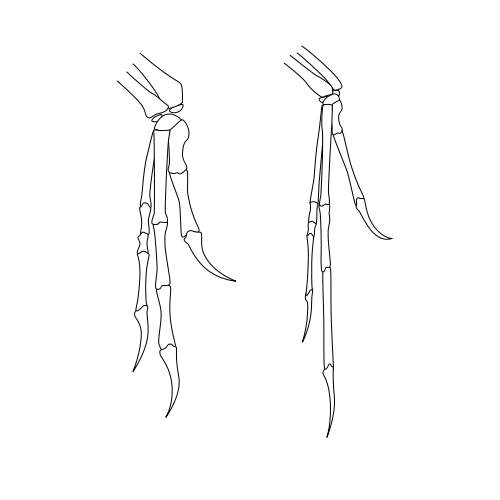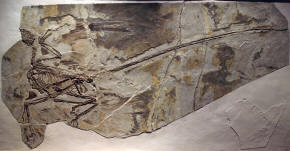|
Unlike most other
saurischian dinosaurs,
which have pubic bones that point forward, several groups of maniraptorans
have an
ornithischian-like
backwards-pointing hip bone. A backward-pointing hip characterizes the
therizinosaurs,
dromaeosaurids,
avialans, and some
primitive
troodontids. The fact
that the backward-pointing hip is present in so many diverse maniraptoran
groups has led most scientists to conclude that the "primitive"
forward-pointing hip seen in advanced troodontids and
oviraptorosaurs is an
evolutionary reversal, and that these groups evolved from ancestors with
backward-pointing hips.
Feathers
and Flight
Modern
pennaceous feathers and
remiges are known from
advanced maniraptoran groups (Oviraptorosauria and Paraves). More primitive
maniraptorans, such as therizinosaurs (specifically
Beipiaosaurus), preserve a combination of
simple downy filaments and unique elongated quills.
Powered and/or gliding
flight is present in
members of
Avialae, and possibly
in some dromaeosaurids such as
Rahonavis and
Microraptor.
Simple feathers are known from more primitive coelurosaurs such as
Sinosauropteryx, and
possibly from even more distantly related species such as the
ornithischian
Tianyulong and the flying
pterosaurs. Thus it
appears as if some form of feathers or down-like
integument would have
been present in all maniraptorans, at least when they were young.
Diet
Scientists have traditionally
assumed that all maniraptorans were primarily
hypercarnivorous, that is, that they primarily
ate and hunted only other
vertebrates. However, a
number of discoveries made during the first decade of the 21st Century, as
well as re-evaluation of older evidence, began to suggest that maniraptorans
were primarily
omnivorous, giving rise
to a number of groups that ate mainly plants, insects, or other food sources
besides meat. Additionally, phylogenetic studies of maniraptoran
relationships began to more consistently show that herbivorous or omnivorous
groups were spread throughout the Maniraptora, rather than representing a
single side-branch as previously thought. This lead scientists such as
Lindsay Zanno to conclude that the ancestral maniraptoran must have been
omnivorous, giving rise to several purely herbivorous groups (such as the
therizinosaurs, primitive oviraptorosaurs, and some avialans) and that,
among non-avians, only one group reverted to pure carnivores (the
dromaeosaurids). Most other groups fell somewhere in between the two
extremes, with alvarezsaurids and some avialans being insectivorous, and
with advanced oviraptorosaurs and troodontids being omnivorous.
Classification
The Maniraptora was originally named
by
Jacques Gauthier in
1986, for a
branch-based
clade
defined as all dinosaurs closer to modern birds than to the
ornithomimids. Gauthier
noted that this group could be easily characterized by their long forelimbs
and hands, which he interpreted as adaptations for grasping (hence the name
Maniraptora, which means "hand snatchers" in relation to their 'seizing
hands'). In 1994,
Thomas R. Holtz
attempted to define the group based on the characteristics of the hand and
wrist alone (an
apomorphy-based
definition), and included the long, thin fingers, bowed, wing-like forearm
bones, and half-moon shaped wrist bone as key characters. Most subsequent
studies have not followed this definition, however, preferring the earlier
branch-based definition.
The branch-based definition usually
includes the major groups
Deinonychosauria,
Oviraptorosauria,
Therizinosauria, and
Aves. Other taxa often
found to be maniraptorans include the
alvarezsaurs,
Ornitholestes
and, less frequently, the
compsognathids.
Sometimes, birds (Aves) has also been classified as
Deinonychosaurs.
Several taxa have been assigned to the maniraptora more definitively, though
their exact placement within the group remains uncertain. These forms
include the
scansoriopterygids,
Pedopenna, and
Yixianosaurus, and the dubious
Bradycneme.
The following
cladogram follows Zanno
et al. 2009, with omitted
clade names after the definitions in Gauthier & De Quieroz (2001) and Sereno
(2005).
Alternate
interpretations
In 2002, Czerkas and Yuan reported
that some maniraptoran traits, such as a long, backwards-pointed,
pubis, short
ischia, as well as a
perforated acetabulum
(a hip socket that is a hole) are apparently absent in
Scansoriopteryx. The
authors considered it to be more primitive than true theropods, and
hypothesized that maniraptorans may have branched off from theropods at a
very early point, or may even have descended from pre-theropod dinosaurs.
Zhang et al., in
describing the closely related or conspecific specimen
Epidendrosaurus, did
not report any of the primitive traits mentioned by Czerkas and Yuan, but
did find that the shoulder blade of
Epidendrosaurus appeared primitive. Despite
this, they placed Epidendrosaurus
firmly within Maniraptora.
Technical
diagnosis
Holtz and Osmólska (2004) diagnosed
the clade Maniraptora based on the following characters: reduced or absent
olecranon process of
the
ulna,
greater trochanter and
cranial trochanter of the
femur
fused into a trochanteric crest. An elongated, backwards-pointing pubic bone
is present in therizinosauroids, dromaeosaurids, avialans, and the basal
troodontid
Sinovenator, which
suggests that the propubic condition in advanced troodontids and
oviraptorosaurs is a reversal. Turner et al.
(2007) named seven synapomorphies that diagnose Maniraptora.
Return to the
Old Earth Ministries Online Dinosaur
Curriculum homepage.
|



